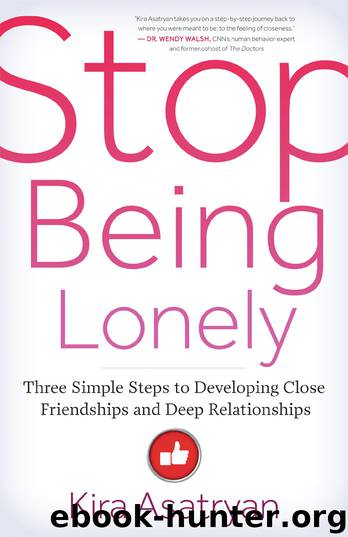Stop Being Lonely: Three Simple Steps to Developing Close Friendships and Deep Relationships by Kira Asatryan

Author:Kira Asatryan [Asatryan, Kira]
Language: eng
Format: epub
Publisher: New World Library
Published: 2016-01-23T23:00:00+00:00
When you empathize deliberately, you’ll consistently gain access to your partner’s emotional inner world — which is necessary for closeness — regardless of what you find there, whether it be scary, sad, depressing, or discomfiting. Empathizing deliberately works in the service of closeness and will produce better results than just feeling and reacting. Let’s learn how to perform each step of this process well.
Step 1. Recognize and Identify the Other Person’s Feelings
The first step in the process of empathizing deliberately is to recognize and correctly identify a feeling in another person. You do this primarily through observation. As I mentioned at the beginning of the book, caring is essentially the same thing as noticing.
Most people provide clues about what they’re feeling through their facial expressions, voice tone, gestures, and so on. When you notice these emotional cues in another person, you begin down the path of correctly identifying his or her feelings.
You already notice some of these cues and know what they look like: your mom has tension in her voice, your sister’s eyebrows are furrowed, your cofounder is relentlessly rubbing his hands together. These signals are floating around us all the time and, for most of us, it’s intuitive to pick up on them. The challenge with noticing these cues is: What do they actually mean?
Does the tension in your mom’s voice mean she’s stressed out or excited? Is your sister angry or just focused? Is your cofounder happy or about to run out of the room? It can often be challenging to jump the chasm from noticing a cue to identifying the feeling that’s behind it.
To help you make this leap, let’s first establish how many feelings people actually have. Traditionally there were thought to be seven fundamental emotions: anger, contempt, disgust, happiness, sadness, fear, and surprise. New research suggests there may be as few as four: anger/contempt/disgust, happiness, sadness, and fear/surprise. For simplicity’s sake, let’s maintain that there are four major emotional states: mad, glad, sad, and afraid.
These are the four states you want to familiarize yourself with and learn to identify in another. The emotional cues you pick up from someone will likely lead you down one of these four paths. Luckily, each emotion has its own hallmarks. Here are the archetypal expressions of the four emotional states:
Download
This site does not store any files on its server. We only index and link to content provided by other sites. Please contact the content providers to delete copyright contents if any and email us, we'll remove relevant links or contents immediately.
The Four Agreements by Don Miguel Ruiz(6630)
Flow by Mihaly Csikszentmihalyi(4634)
The Four Tendencies by Gretchen Rubin(4544)
Adulting by Kelly Williams Brown(4487)
You Do You by Sarah Knight(4416)
The Hacking of the American Mind by Robert H. Lustig(4318)
Ikigai by Héctor García & Francesc Miralles(4125)
Right Here, Right Now by Georgia Beers(4124)
A Simplified Life by Emily Ley(4099)
The Art of Happiness by The Dalai Lama(4063)
The Power of Positive Thinking by Norman Vincent Peale(4002)
The Little Book of Hygge by Meik Wiking(3647)
The French Women Don't Get Fat Cookbook by Mireille Guiliano(3604)
The Heroin Diaries by Nikki Sixx(3493)
The Choice by Edith Eva Eger(3421)
The Courage to Be Disliked by Ichiro Kishimi & Fumitake Koga(3414)
Why Buddhism is True by Robert Wright(3404)
Spark Joy by Marie Kondo(3249)
Make Your Bed by William H. Mcraven(3120)
